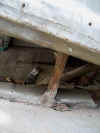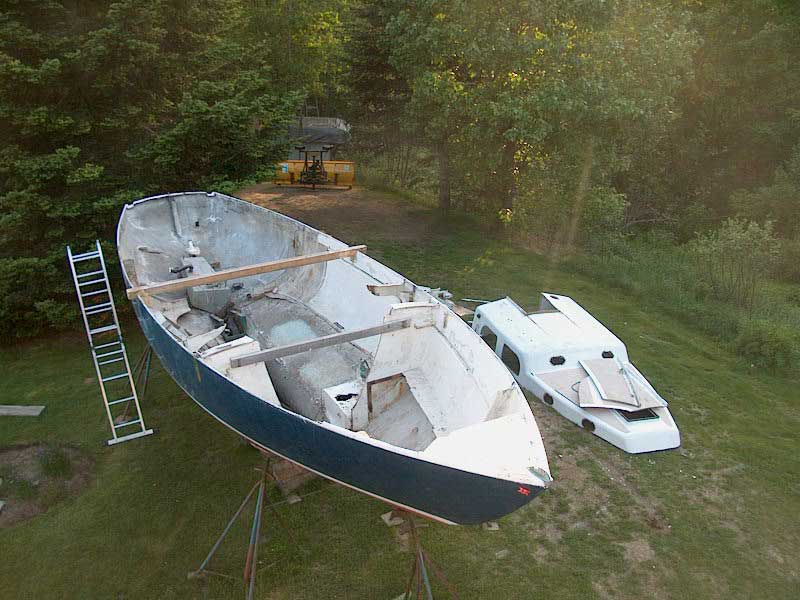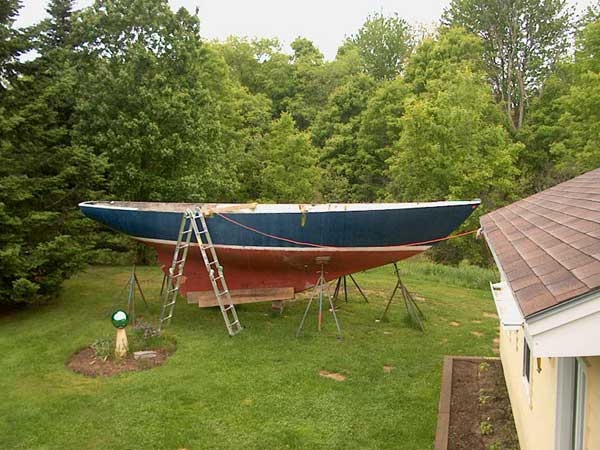|
| |
| Wednesday, June 4, 2003 With
the cabin trunk off in one piece, we turned our attention to the remaining
sidedecks, cockpit, and toerail. The cabin trunk had come off so
easily, and with a minimum of fuss; certainly, having Nathan on hand was a
big help so far, since I never would have tried moving the cabin trunk in
one piece otherwise. (My plan had been to cut it into manageable pieces as
needed.) But it soon became apparent that the trunk was the easy
part of the job. The cockpit was
next. I hoped to remove it in one large piece, since in demolition
it always pays to get at much out in as few pieces as possible--less work,
obviously. So we cut around the edges of the cockpit along the
narrow sidedecks and across the poop deck, which more or less freed the
bulk of the cockpit. However, there were a couple thorns in our
side: a plywood brace that was installed athwartships beneath the
middle of the cockpit, and the rudder tube, located just aft of the
brace. I wanted to retain the rudder tube at least for now, since I
didn't know exactly how I planned to handle that later on, so the easiest
thing to do was to basically cut out around the rudder tube through the
cockpit floor, beginning at the lazarette hatch beneath the poop deck and
cutting a roughly boat-shaped piece of the cockpit sole that would allow
the rest of the cockpit to be removed without harming the rudder tube.  Next,
we had to deal with the glassed-in brace. Of course it could be cut
out from beneath, but it seemed ridiculous to crawl deep into the
nastiness beneath the cockpit to remove a brace from an area that would
shortly be completely open and free anyway. Instead, I cut through
the cockpit sole and sides on each side of the brace, leaving a small section
of the sole on top of the brace. A former owner had modified the
original cockpit, which featured the side-opening locker hatches common on
early Tritons, and had filled in the original openings and installed
poorly-constructed horizontal lids in the seats. On the port side, a
swift kick with my foot took care of most of the badly delaminated plywood
and cheap fiberglass. The fiberglassed fuel tank was still in place
to starboard, in the standard location in the locker, and we used care to
avoid cutting into it, since it appeared to be rather full of fuel (or
something). Next,
we had to deal with the glassed-in brace. Of course it could be cut
out from beneath, but it seemed ridiculous to crawl deep into the
nastiness beneath the cockpit to remove a brace from an area that would
shortly be completely open and free anyway. Instead, I cut through
the cockpit sole and sides on each side of the brace, leaving a small section
of the sole on top of the brace. A former owner had modified the
original cockpit, which featured the side-opening locker hatches common on
early Tritons, and had filled in the original openings and installed
poorly-constructed horizontal lids in the seats. On the port side, a
swift kick with my foot took care of most of the badly delaminated plywood
and cheap fiberglass. The fiberglassed fuel tank was still in place
to starboard, in the standard location in the locker, and we used care to
avoid cutting into it, since it appeared to be rather full of fuel (or
something).
|
|





|
|
With all the various
freeing cuts made, the cockpit became loose and dropped down a small
amount. At first, we tried prying up one side, while standing on
ladders outside the boat, in the hopes of catapulting it over the opposite
side. Nope--that wasn't going to happen. The cockpit was too
heavy, too bulky, and hung up on a couple of the cut areas. So,
instead we climbed into the boat and began selective surgery on the front
part of the cockpit, cutting away first the bridgedeck (cored, on this
boat), then the forward end of the cockpit to allow a better grip and
simply to remove some weight. The cutting was somewhat complicated
by a deep pool of water in the forward corner of the cockpit, right where
I wanted to cut. I didn't relish the idea of running my electric saw
through deep water, so eventually we managed to twist and torque things
till the water ran off into the bilge.
With the forward portion of
the cockpit cut away, we found we could more easily heft things
around. Still, the unit was badly hung up on the double cuts we had
made across the center, in way of the underlying support. Nathan
climbed back there, gingerly making his way across the shimmering cockpit,
and increased the size of the cut in a few places, and with that, we were
finally able to free the cockpit and start moving it to the side. It
was still heavy and awkward, but we soon had it perched on the port rail,
and after freeing the copper fuel tank vent, we gingerly made the attempt
to throw it over the side. It didn't quite act the way we
anticipated as it fell, but the end result was what we wanted: it
was now on the ground and out of the boat. No harm done to anything
or anyone. |
|





|
|
With the cockpit now out of
the boat, the hull really looked empty. Of course, the hull was full
of debris, both from the demolition and plenty of pre-existing stuff that
had already been jammed in beneath the cockpit and other areas. It
seemed really odd to look aft and see only the inside of the hull!
The ornery brace beneath the cockpit could now come out with a few hard
kicks. |
|




|
|
After taking several
minutes to marvel at the mess we had created, it was time to saw out the
remaining sidedecks. I planned to remove the decks and toerail down
to the natural seam between deck and hull, which seemed like the most
logical--and cosmetically pleasing--line to which to cut. When I cut
out the small deck sections earlier in the day to install my cross beam,
the cut provided a clear insight into the toerail construction. It
looked like the best way to remove the decks would be to cut vertically
through the toerail, which would free the bulk of the sidedecks and remove
any further obstructions to cutting the remaining part of the toerail off
from the outside by following the seam. While it would have been
nice to simply make one cut from outside the boat, following the seam, I
found that because of the design of the toerail and deck, the saw would
have to angle slightly downward (from outside to inside) to clear the
inside of the toerail; this would leave an angled cut on top of the hull,
which I didn't want, and since this particular cutline is very
important--it will define the sheer from here on out--I didn't want the
cut to be imprecise.
Cutting through the toerail
vertically through the top, down its basic centerline, was fairly
straightforward and wend pretty fast. It got trickier near the stem,
where the flare of the hull started to interfere with cutting, so we left
a small section of the foredeck in place to be dealt with later.
Taking turns, Nathan and I sawed our way all around the boat, freeing
small sections of the deck at a time. The pieces of sidedeck and foredeck
were inordinately heavy, it seemed, especially after we had found
the entire coachroof to be lighter than expected. All the core was
wet and saturated with water, and was badly damaged in all areas (not a
surprise). Because the forward two bulkheads were still at least partially intact, we simply cut around them for now, leaving small
sections of the deck in place for cleanup later. |
|





|
|
It was getting late in the
day now, and we were both pretty tired. Still, we hoped to get the
remainder of the toerail sawed off, which would really give a clear
picture of what the hull was going to look like sans deck. I
decided that it made sense to use my jigsaw to cut through the seam, since
it was a much more precise tool than the Sawz-all. The cutting
wasn't too bad, but cutting thick fiberglass with a small blade is always something
of a slow process, and after a while it became clear that we were
pretty much ready to stop for the day. After breaking a series of
blades, I decided that it must be a sign, and called a halt to the
work. In about 6 hours' time, we had managed to stiffen the hull,
removed the entire deck (except for a few small portions), and make a huge
pile of trash next to the boat.
We decided that we had to
climb up on the nearby shop roof in order to get a better view of the boat
in its entirety. The view was definitely pretty cool! It was a
long, but very satisfying, day's work. Special thanks to Nathan for
his help, without which the process never would have gone as quickly or
smoothly--and also for his assistance in taking photos of me at work,
something that is impossible during all the time I work alone.
|



|
|
 |
|





|
|
A few days later, I cleaned
up the trash pile next to the boat, moving it to a nearby section of the
yard where it was less in the way. I found I could drag the large
pieces--the coachroof and the cockpit--with my tractor, and then I stacked
all the smaller bits inside the upturned coachroof for temporary storage
while I cut up the larger pieces, remove any remaining deck hardware that
needs to be saved, and prepare everything for disposal. Bit by bit,
as time allows, I'll carve things into manageable pieces and throw some
away in the weekly trash pickup (I love my trash pickup. They take everything--glad
I get something for my tax dollars, after all!)
 As of this writing, much
work remains on the hull and what is left of the deck. The rest of
the toerail needs to be cut away, I need to drain and remove the fuel
tank, add a third stiffener across the after part of the hull, and cut out
some of the remaining bulkhead pieces. Then, I can clean up the
inside and prepare for mucho grinding. As of this writing, much
work remains on the hull and what is left of the deck. The rest of
the toerail needs to be cut away, I need to drain and remove the fuel
tank, add a third stiffener across the after part of the hull, and cut out
some of the remaining bulkhead pieces. Then, I can clean up the
inside and prepare for mucho grinding.
|
Continue>
|
|

|
|































